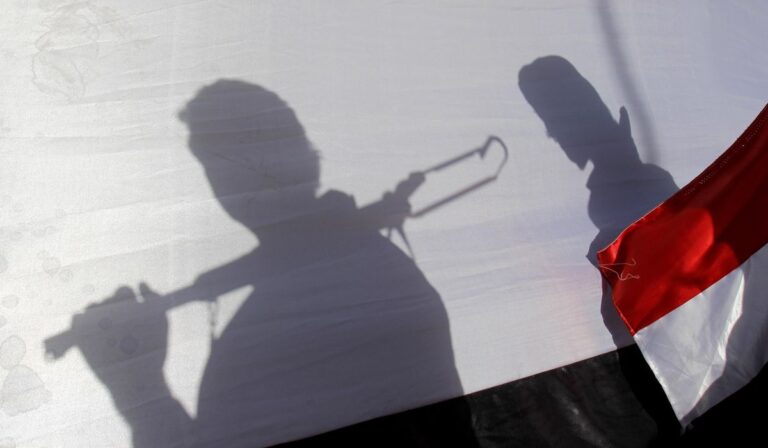
They have gone from a little-known rebel outfit in one of the world’s poorest countries to a household name that can directly impact global commerce, regional security and international energy markets — and there is no easy way to stop them.
Yemen’s Houthi rebels, financially and logistically backed by Iran, have emerged as key players in a conflict that began with Hamas’ Oct. 7 terrorist assault on Israel but has quickly spread across the Middle East.
As other Iranian proxies clash with U.S. troops in Iraq and Syria, the Houthi rebels are using cheap drones and anti-ship missiles to target commercial vessels transiting the Red Sea.
U.S. forces have been battling the Houthis on a near-daily basis. Late Tuesday, the Pentagon said U.S. forces had shot down 12 one-way attack drones, three anti-ship ballistic missiles and two land attack cruise missiles fired by the Houthis over a frantic 10-hour period in the southern Red Sea.
The unfolding U.S.-Houthi conflict is unexpectedly shaping up to be perhaps the most far-reaching spinoff of the Israel-Hamas war. Leading commercial shipping companies are rethinking routes through the violent and dangerous Red Sea. The energy sector is watching nervously to see whether the Houthis grow more aggressive against oil tankers passing through the region’s narrow maritime chokepoints.
The U.S. and its allies have launched a maritime security task force to slow the Houthi attacks, but analysts warn that the Yemen-based group has discovered it can exert an outsized impact on the rest of the planet with little fear of consequences.
“For the Houthis, this is their time to shine,” said Brigham McCown, a senior fellow at the Hudson Institute and director of the think tank’s Initiative on American Energy Security.
“They’re getting their 10 minutes of fame because they’ve stumbled upon … an opportunity to play a major role with very little risk in their minds,” said Mr. McCown, a retired naval aviator. “They’re launching drones, they’re launching missiles from mobile sites, difficult to pin down.
“From a risk-reward calculus, they’re on the big stage and nothing seems to really be happening to them. Whereas the U.S. is shooting multimillion-dollar missiles at cheap drones and more rudimentary anti-ship missiles,” he said. “Even if one wanted to escalate to deter the Houthis, how on earth do you do that?”
Expect more attacks
The Biden administration is struggling with that very question. Iran and its other regional proxies and allies — Gaza-based Hamas, Lebanon-based Hezbollah, Iraq-based Shiite militia Kataib Hezbollah and others — seem at least partially vulnerable to military pressure and, to some degree, operate under more traditional cost-benefit analyses.
Hezbollah in Lebanon has not thrown itself entirely into a war with Israel, knowing such a move would carry significant consequences.
Iran-backed militias in Iraq and Syria regularly target and, in some cases, injure U.S. troops. Still, they seem to be measuring their moves around the knowledge that the U.S. could strike back with fury.
American forces struck Kataib Hezbollah positions in Iraq hours after a Christmas Day drone attack wounded three U.S. troops at Irbil Air Base.
Regional analysts say the Houthis aren’t susceptible to direct U.S. military retaliation in the same way. The group appears to be well aware that the U.S. is reluctant to carry out direct strikes on Houthi targets inside Yemen to prevent further escalation of the Middle East conflict.
American strikes in Yemen also could derail intensive United Nations-backed peace talks aimed at ending the country’s long-running civil war.
Furthermore, the Houthis were subject to years of bombing by a Saudi-led military coalition during that civil war. Analysts say the militants are well-accustomed to such attacks and may not fear them in the same way other groups might.
U.S. visibility into Yemen also may be more limited than in Iraq or Syria, perhaps making it more difficult to identify with certainty the correct Houthi targets.
Doing nothing doesn’t seem like an option.
Some analysts are calling on the Biden administration to take a tougher line toward the Houthis, Kataib Hezbollah and all other Iran-backed groups in the region — lest a widening U.S.-Iran conflict spread further and result in more bloodshed.
“This is what happens when deterrence by punishment is forsaken,” said Behnam Ben Taleblu, a senior fellow at the Foundation for Defense of Democracies.
“Expect more, not fewer, attacks towards Israel as well as diminished freedom of navigation in the Red Sea,” Mr. Ben Taleblu wrote in an analysis that the think tank published this week.
“Anti-ship ballistic missiles, suicide drones, and land attack cruise missiles in the hands of the Houthis are brought to you by the Islamic Republic of Iran, full stop,” he wrote.
Economic impacts
On Christmas Eve, a Houthi attack drone hit a Gabon-owned, Indian-flagged crude oil tanker in the Red Sea.
In a worst-case scenario, such incidents become more common and destabilize energy markets by forcing tankers and other vessels to sail around Africa rather than transit through the Red Sea and Egypt’s Suez Canal, analysts say.
About 30% of global container traffic and more than 1 million barrels of crude oil per day head through the Suez Canal, according to an Associated Press report citing the global freight booking platform Freightos Group.
So far, energy markets have mostly absorbed the uncertainty. Oil prices rose Tuesday but slipped back down Wednesday.
Still, problems could arise over the longer term.
“If ships are required to circumvent the Red Sea and Suez Canal … we’re adding between one and two weeks of transit delay,” said Mr. McCown. “That all has substantial costs.”
Mr. McCown said he doesn’t see “$100 per barrel oil” on the horizon.
Prices stood at less than $80 per barrel as of Wednesday afternoon, but oil isn’t the only concern. As of Dec. 17, at least 280 container vessels have been diverted away from the Red Sea because of Houthi attacks


